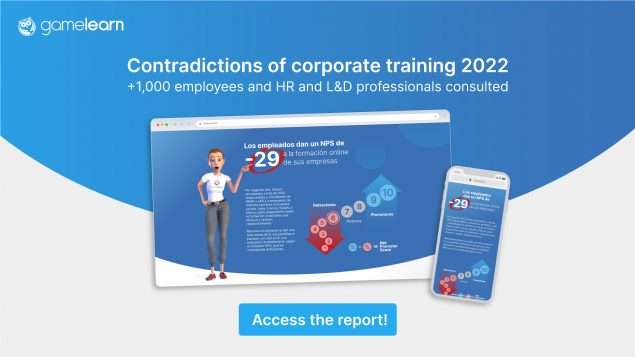Many companies have already adopted the NPS (Net Promoter Score) as an indicator of success. It is a key metric for evaluating a business, including customer satisfaction with the service. This system has gained in popularity, but did you know that there is another metric to measure the satisfaction of a company’s employees (or “internal customers”)?: the eNPS (employee Net Promoter Score).
The eNPS is a relevant indicator for organizations that want to build a successful team, motivate their employees, and attract and retain talent. The NPS measures the likelihood that a customer will recommend your company. The eNPS measures the likelihood that an employee will recommend your organization as a good place to work and, therefore, the likelihood that they will speak well of your products and services to others.
In this way, the eNPS makes it possible to estimate the level of employee loyalty. An employee with a low level of loyalty to the organization is less likely to recommend it as a good place to work. On the other hand, committed employees tend to attract others to the team. For each employee on the team, whether considering the entire organization or a specific area, a survey consisting of two questions must be submitted:
- On a scale of 0 to 10, how likely are you to recommend this company as a good place to work?
- On a scale of 0 to 10, how likely are you to recommend this company’s products or services to a friend or colleague?
Employees’ answers will fall into one of these categories:
- 0 to 6: Detractors. These employees would not recommend the company. In addition, they are likely to talk about the organization negatively. They’re also employees with low loyalty, which means they can leave the company at any time.
- 7 and 8: Neutral. They don’t dislike the organization, but they don’t recommend it either. Although there is no immediate risk of them leaving the company, they could become detractors if things do not improve.
- 9 and 10: Promoters. They highly recommend the organization to others. This is positive for the company’s reputation and helps to attract more talent. In other words, they’re committed to their company.

Offering opportunities for continuous professional development
All members of your team deserve the opportunity to grow and develop their skills while working under your leadership. If you want to set your team up for success, you can provide them with useful tools and resources to achieve their professional development goals. One way to do this can be to actively offer different development opportunities to each team member, allowing them to choose what they feel is appropriate to enhance their career. If you manage a remote team, make sure they have the opportunity to improve their skills while working outside the office. This could be through industry-specific e-learning courses. By offering training, you show your employees that you care about their careers, which will make them feel valued and increases the chances that they will want to stay with the company.
Creating individualized development plans
By spending time with each team member, you can get to know them and identify their individual learning styles, which is crucial to their development. Spending time discussing what your team members believe will benefit them most can help you to create a customized development plan for each one. This can increase productivity and make them feel more valued and respected in the workplace. To create a plan, discuss their career goals and their current strengths and weaknesses. Also, think about the types of goals you can help them achieve through coaching or mentoring. If you work in a small business, creating these plans can be fairly easy. Larger companies can also develop strategies to ensure the creation of individualized development plans that can help each employee develop and enhance their unique skills.
Investing in e-learning
One of the great benefits of investing in online training for employees is increased engagement. This type of training goes beyond the traditional model and encourages professionals to learn. It increases motivation and allows employees to set their own schedules. These are some key points for the success of online employee training:
- Investing in content that is relevant to learners, i.e. think about who your target audience will be.
- Offering materials and tools that are easy to access, not complicated or time-consuming platforms. Analyzing which courses meet the training objectives of the company.
- Using innovative approaches, with a variety of formats, including: videos, tests, live broadcasts, forums, infographics, images, texts, suggested readings, games (gamification), game-based learning, etc.
- Supporting students’ problem-solving.
- Making it possible to dedicate time to longer courses, divided into separate classes, or simply providing faster and more easily absorbed training.
Finally, when you effectively invest in online learning for employees, both the company and the employees benefit. Indeed, in order to retain talent, a company must invest in the qualification and motivation of its professionals. Resorting to online courses is currently the most cost-effective way to achieve this goal.
To know whether training is effective, the company must monitor the performance of its employees. This can be done by conducting evaluations at the end of each course. Comments and feedback from students should also be taken into account and encouraged. They can talk about the positive and negative points of each course. In this way, the company will know how to improve and, with each new class, will offer more relevant methods with greater engagement.
What is employee development and why is it important?
Employee development is a process consisting of initiatives and programs designed to improve the existing skills and knowledge of a team. This training process can help ensure that all team members are able to grow professionally. Resources that help employees develop their skills can take many forms: training exercises, team-building activities, workshops, seminars, etc. Employee development ensures that team members contribute the most to the company they work for and that the company pushes them to achieve their professional goals. This mindset can help your team to be innovative and the company to grow. Improving employee development opportunities can bring a number of benefits, such as a healthy work environment, increased engagement, and improved productivity levels.
How can you increase your company’s productivity?
One of the great challenges of any organization is to improve productivity and efficiency. To achieve the desired result, the company’s challenge is to give its employees access to new tools that facilitate routine and optimize time.
Today, various tools are used to improve employees’ skills: e-learning platforms offer a wide range of courses for your employees. Some are traditional and allow follow-up with an instructor, others use a video game-based methodology with the help of authoring tools or a ready-made catalog. These methods enable managers and L&D teams to identify concrete opportunities to increase productivity in their company.






